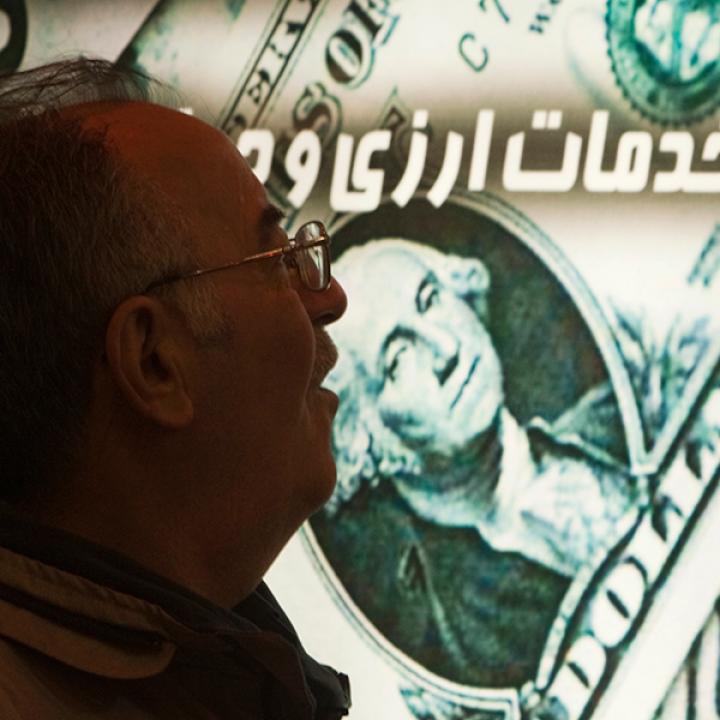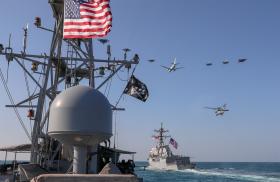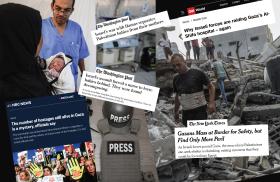
- Policy Analysis
- PolicyWatch 3977
Making Iran Choose Between the Bomb and Bankruptcy

The regime’s fears of new oil restrictions, simmering domestic unrest, eroding regional deterrence, and unpredictable U.S.-Israeli military action can all be leveraged to steer Khamenei away from racing toward a nuclear weapon.
After the major setbacks experienced by its so-called “axis of resistance” over the past year, the Islamic Republic stands at a crossroads, and which direction it chooses is up for debate in Tehran. The international community is worried the regime might follow North Korea’s path and consider testing a nuclear bomb to deter adversaries from contemplating an attack. The challenge for Washington is convincing Tehran that the costs of this option—both literal and existential—would be too high.
Currently, the regime appears to be of two minds on this issue. One camp is advocating escalation across multiple fronts, particularly the nuclear front. Ahmad Naderi, a member of the parliament’s executive committee, suggested that Iran should “conduct a nuclear test and officially announce it” to achieve “maximum deterrence.” Similarly, parliamentarian Ahmad Bakhshayesh Ardestani, a member of the national security committee, suggested the government should first increase uranium enrichment to 70-80 percent and then move toward developing a bomb. (For more on enrichment percentages and related issues, see this Washington Institute infographic or the associated Iran Nuclear Glossary.) Although Supreme Leader Ali Khamenei has not specifically commented on the nuclear issue of late, these voices align with his generally defiant public rhetoric against the United States, including earlier this month.
In contrast, other regime voices have signaled a willingness to return to the negotiating table and talk with the incoming Trump administration. Ali Larijani—the former speaker of parliament who was previously sidelined but then rehabilitated as an advisor to Khamenei—hinted at this in an interview published on the Supreme Leader’s website: “I heard the new U.S. administration say they don’t accept the [2015 nuclear deal] because the Iranians tricked them...So let’s move on to a new topic: You say you accept a nuclear-capable Iran as long as it doesn’t pursue a bomb...So let’s agree...We are not going for a bomb, if you accept our conditions.”
Problems at Home
While considering his next move, the Supreme Leader will need to carefully weigh the ramifications of any escalatory actions, since they could lead to further isolation and exacerbate Iran’s faltering infrastructure and economy. Having violently suppressed three major protest movements since 2018, the regime remains deeply fearful of another uprising (e.g., Khamenei advisor Ali Shamkhani recently voiced concern over the increasing frequency of mass protests).
This fear explains the regime’s reluctance to decrease the country’s unsustainable fuel subsidies, which place significant strain on the economy. The government has avoided raising fuel prices for years, wary of sparking unrest akin to the 2019 protests triggered by a previous price hike. Recent reports suggest that the Supreme Leader may have intervened in discussions on increasing prices in the near future, underscoring that this is no longer just an economic choice but one of the regime’s most pivotal national security decisions.
Indeed, Iran’s long-declining economy has reached a critical point where the government is struggling to provide basic services. The electricity sector is deteriorating rapidly, and officials can no longer guarantee a continuous power supply throughout the year. Systemic failures are also evident in the natural gas sector, the public’s primary energy source for heating. The national currency is plummeting as well, driving daily increases in the cost of essential goods even before the anticipated return of Trump’s “maximum pressure” policy.
Fears of another uprising have forced the regime to cede control of certain public spaces, particularly regarding its compulsory hijab policy. In major urban centers, women are increasingly adopting more liberal styles of dress. Although this shift has angered hardliners, the regime’s ability to enforce stricter measures is constrained by its realization that previous crackdowns sparked the massive Mahsa Amini protests, revealing the fragile balance between ideological control and social stability. After hardliners in the legislature recently passed a new hijab law, both President Masoud Pezeshkian and Speaker of Parliament Muhammad Baqer Qalibaf refrained from enacting it. Later, the Supreme National Security Council—whose members include the commander-in-chief of the Islamic Revolutionary Guard Corps (IRGC)—decided to pause enforcement of the law, signaling the regime’s deep fear of civil unrest.
When facing international setbacks in the past, the regime would often intensify domestic repression (especially against women) in order to deter rebellion and counter perceptions of weakness. Today, however, the regime cannot even enforce a new hijab law after suffering some of the most serious regional blows in the Islamic Republic’s history—a shift that may reveal much about its domestic power dynamics. The fact that further economic hardship could heighten the risk of domestic dissent will no doubt influence Khamenei’s decisionmaking about nuclear escalation.
Problems Abroad
In Iraq and other locales, influential “axis of resistance” figures linked to the Supreme Leader’s office have recently been advocating another round of escalation against U.S. interests in the region, including U.S. embassies. In their view, such action would preempt supposedly imminent escalation by Israel and the incoming Trump administration. Yet Khamenei and other hardliners will face significant difficulties if they attempt to mobilize their remaining functional militia proxies, particularly in Iraq.
The Islamic Republic’s longstanding “cognitive warfare strategy” rests on two pillars, both of which have been seriously weakened. One is mazloumiyat (victimhood), a deeply rooted Shia concept that was central to Tehran’s calls for intervention in Syria a decade ago. The regime began by deploying IRGC personnel and foreign militias to the Damascus area under the pretext of protecting the shrine of Sayyeda Zainab, sister of Imam Hussein, who is said to have been taken prisoner after the Battle of Karbala in 680 AD—a defining event that deeply affected Shia identity. As the Syria intervention expanded, Tehran continued to justify it with the slogan “Zainab will not be taken prisoner for a second time,” repeatedly referring to the deployed forces as Modafean-e Haram (Defenders of the Shrine [of Zainab]). Notably, the Sunni officials who recently took control of Damascus after ousting the Assad regime have spared the shrine, undermining Tehran’s moral justification for continued Shia sacrifices at its behest.
The second pillar, eqtidar (authoritative power), is a concept that portrays Iran as a dominant force under the guidance of “the sagacious Supreme Leader” (rahbar-e farzaneh). This image helped Tehran expand its militia network and attract recruits by projecting alignment with the “victorious” side. Yet recent setbacks have severely eroded this perception of might—a problem compounded by the internal divisions and crisis of leadership that have emerged within the IRGC-Qods Force.
Another limitation to any regional escalation is Tehran’s risk of losing its remaining operational forces. This is particularly true in Iraq, where the U.S. military has precise intelligence on key militia figures and the proven capability to target them. This risk has seemingly convinced certain “resistance” figures—most notably Qais al-Khazali, leader of the U.S.-designated terrorist organization Asaib Ahl al-Haq—to hide in Iran under the pretext of pursuing “seminary studies.”
What Kinds of Pressure Are Most Meaningful to Khamenei?
Despite his strident public rhetoric, the Supreme Leader is likely aware that the regime’s past security strategy is collapsing. That strategy was based on foreign militias to provide defensive depth, missiles to bolster deterrence, nuclear breakout as a longer-term deterrent, and internal crackdowns as a means of crushing dissent without serious repercussions. Some of Khamenei’s advisors seem stuck in this old school of thought, counseling “resistance” on all fronts. Yet the recent costs of this approach are undeniable even in Tehran.
Amid this situation, what external actions are most likely to push Khamenei away from the nuclear threshold? What kinds of pressure would be most meaningful to him given the domestic pressures his regime is currently under? Although there is no guarantee how he would react to more pressure, he has often been cautious when confronted with circumstances that could threaten the Islamic Republic’s stability.
In that sense, one potentially significant deterrent to nuclear escalation is the prospect of enhanced U.S. enforcement of sanctions on oil sales, which would limit resources available for the core strategic elements listed above—namely, militias, missiles, and the subsidies that keep a lid on domestic dissent. Such a move would likely worsen Iranian public sentiment, a challenge the regime is making every effort to avoid. The Supreme Leader might also be concerned by the prospect of U.S. and/or Israeli military action if no nuclear agreement is reached in the near term.
Many in Iran see Trump as an unpredictable leader who likes to strike deals but who is also prepared to come down hard on Tehran. Played skillfully, this combination could give him leverage with a regime that is already debating how to approach his administration. So long as that debate continues, Tehran is less likely to make a bold gamble on developing a nuclear bomb, especially if Khamenei fears how Iran’s adversaries would react.
Hamdi Malik is an associate fellow with The Washington Institute and a regular contributor to its Militia Spotlight platform.


